Potential customers visit your site, then disappear without a trace.
You pitched your services to a promising prospect—and never hear from them again.
It feels like there’s a warning sign on your business telling customers to stay away. But the problem might not be with your site or presentation at all. It might be what they see elsewhere.
We all trust what other customers say. And if you don’t have reviews to back up your claims, you’ll struggle to find the customers and clients you deserve. The answer to building a trustworthy business may lie in how you ask for customer reviews.
No customer journey is the same, and reviews are a crucial touchpoint that can help reinforce customer interest and acquire new prospects at the same time.
Today, we’ll discuss the best strategies for customer review automation. You’ll understand how to drive customer loyalty and bring in new prospects with a steady stream of testimonials. And you’ll learn some of the best strategies for boosting your results.
Let’s get started!
In this article
Why online reviews matter for your business
Customer reviews can attract or repel new prospects.
Customers are looking for social proof, whether you’re a scrappy upstart or an established brand. Recent customer service research has shown that 86% of millennials say they’re influenced by negative reviews before buying a product or service.
Online reviews are how you can build the credibility new customers are looking for. In addition, it also offers several benefits for your growing business.
Create loyal customers
That’s right—customers who leave a review with your brand tend to be more loyal than those who don’t.
And it’s not just because they’re happy customers. The act of leaving a review in and of itself can bolster engagement and buy-in.
The psychological effect at work is what Robert Cialdini calls “Consistency” in his seminal book Influence. Put simply, customers who write a positive review of your brand feel more connected to it and are more likely to give future personal recommendations.
Generate sales
We all know that reviews can help convert more sales. But merely having a trustworthy presence on a review site can help generate leads for SaaS.
If you’ve been in business for more than a year, there’s a good chance third-party review sites already have your company’s profile. But that information might be outdated, and it’s almost certainly not optimized.
Claim your profile, add updated information and media, and optimize your page with reviews. You can start collecting leads from visitors already on the site.
Fewer price objections
Every business owner dreams of creating a brand that speaks for itself—no more customers haggling over prices or comparing your offerings to a cut-rate competitor. The secret to building this kind of brand is to position that you are the only solution that will work.
And one of the best tools to make that message clear? Reviews. Positive reviews can help you build a strong brand that helps customers see beyond price objections. The stronger the social proof you can offer, the lesser the price will matter. And even for price-conscious customers, positive reviews tilt the scales in your favor.
Learn from customer feedback
As business owners, we often think of reviews as either positive or negative. But oftentimes, customers use them to share constructive ideas that can help grow the business.
A recent study showed that one in five customers left reviews because they had an idea of how to improve the product.
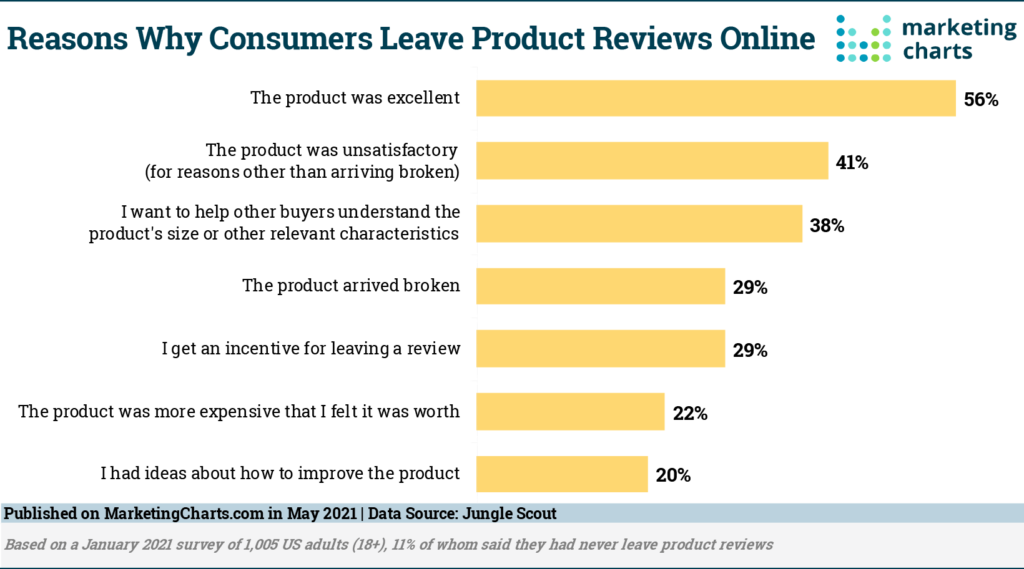
Reviews can be a great way to collect important customer feedback and gain new insights into your business. And as a bonus, positive comments with ideas for improvement are a great indicator that you’re not relying on fake reviews.
Putting it all together, almost every business needs customer reviews. Whether you’re looking to acquire new customers or keep your existing customers happy, they matter.
But asking for reviews manually isn’t always the best way to go.
How to automate customer reviews
While reviews can transform your business, it takes time to collect them.
You’ll need to contact each customer at the optimal time, filter out unhappy customers, ask for a review, and send occasional reminders to those who forget.
Thankfully, you can use automation to handle the process. There are several benefits to automating customer reviews:
- Less work. Instead of spending hours on manual outreach, review automation can contact customers and send follow-ups while you work on other priorities.
- Better timing. Your team would struggle to send emails at the perfect time to every customer, but marketing automation can make it easy—ensuring you get more responses and more positive reviews.
- More reviews. You might miss someone, but an automated system will reach out to all buyers. That means more engagement and more reviews.
- Improved consistency. You can measure automated processes over time and improve them to get better results.
Here’s how to get started.
Create a workflow that works for you
First, you’ll want to connect your automation process to the customer relationship management (CRM) software. This provides the information on each customer you’ll need to collect user reviews.
Look for triggers in customer behavior to start the process. The most obvious trigger might not be the right one. For example, you’ll probably get better results if you ask after a customer receives a product rather than when they first place the order.
For example, this review request email from Outdoorsy asks after the trip is finished, not after the original booking:
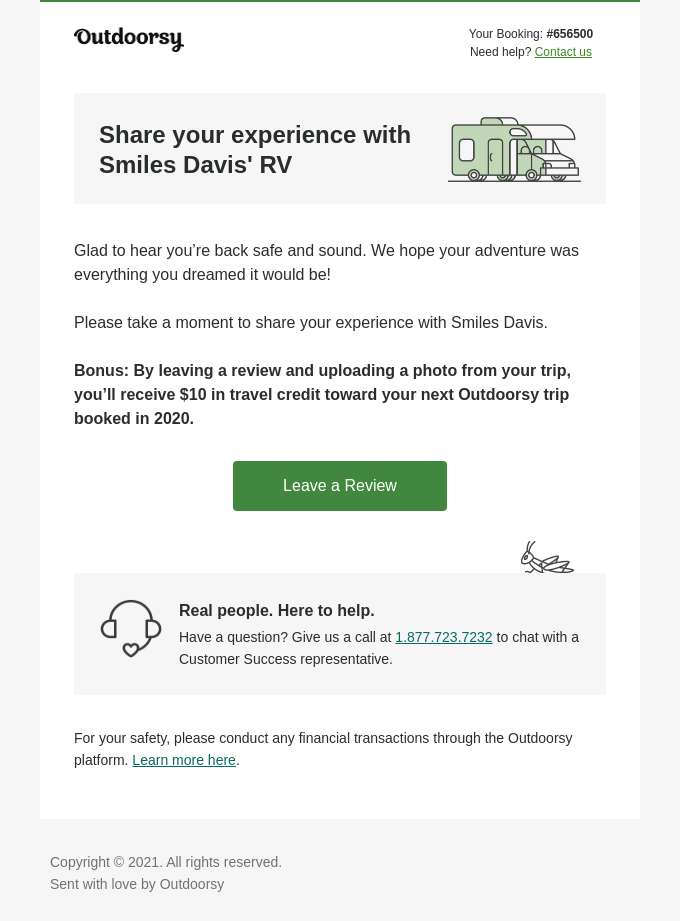
The next step after the trigger will probably be filtering out the negative feedback. A simple question like “are you enjoying our service so far?” can help flag unhappy customers early on, which you can then redirect to customer support and use helpdesk software to filter out which customers are happiest with your service and offering. Ask the happy customers to share a review, thank them when they do, and remind them if they forget.
Prepare messages
The difference between effective and ineffective sequences lies in the words you use. You’re asking the customer to do a favor that takes time and effort, so be polite and don’t send more than one or two reminders—too many and they can backfire by frustrating the consumer.
And even if you’re sending an automated email, make it as personal as possible. That includes using the customer’s first name, signing off as a real person, and perhaps even referencing personal information like the customer’s product.
For example, this email from Moment references the customer name and the product purchased:
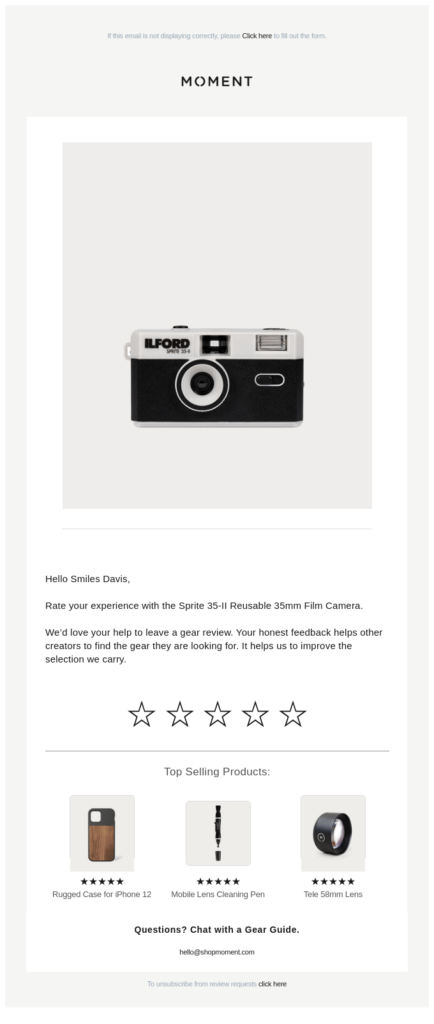
Source: Really Good Emails
And instead of just asking for a review, it explains how the review will help other creators choose gear and help Moment carry the best products. This kind of explanation (beyond pure self-interest) can motivate apathetic customers to help others.
Measure, test, and improve your process
As with any kind of automation, you’ll never have the perfect workflow. As you ask for customer reviews, you’ll learn what phrasing to use and see opportunities for better results.
The three most significant areas for improvement will probably be finding better triggers, revising your ask, and adjusting how you handle reminders. Measure which steps in the sequence have low engagement and test new angles.
With that basic process, you can put review collection on autopilot. But some additional strategies can help you deliver even better results.
Strategies for customer review automation
Now that you have the basics of automating customer reviews let’s look at some strategies to improve your results. You can use these from the outset or test them on a live campaign.
Choose a specific platform
The clearer your review request, the better results you’ll get. While you might appreciate a positive review anywhere, ask customers to leave feedback on a specific site. If you need reviews on several platforms, you can create an automation to point different customers to different sites.
Choose the website that matters most for your business and industry.
- G2 Crowd or Capterra are common for software companies
- Clutch focuses on freelancers and agencies
- Trustpilot has reviews for retailers and service industries
- Google My Business and Yelp are best for brick-and-mortar businesses and restaurants
And of course, you can also ask for reviews on your own site—just set up an easy-to-use form to collect them.
Reduce friction to leaving positive feedback
The fewer clicks it takes to leave you a review, the better. If you can, send a link that automatically opens a “create new review” window. Even better, include clickable stars in the email itself so a customer can rate a product in a single click.
This email from Mack Weldon does it nicely:
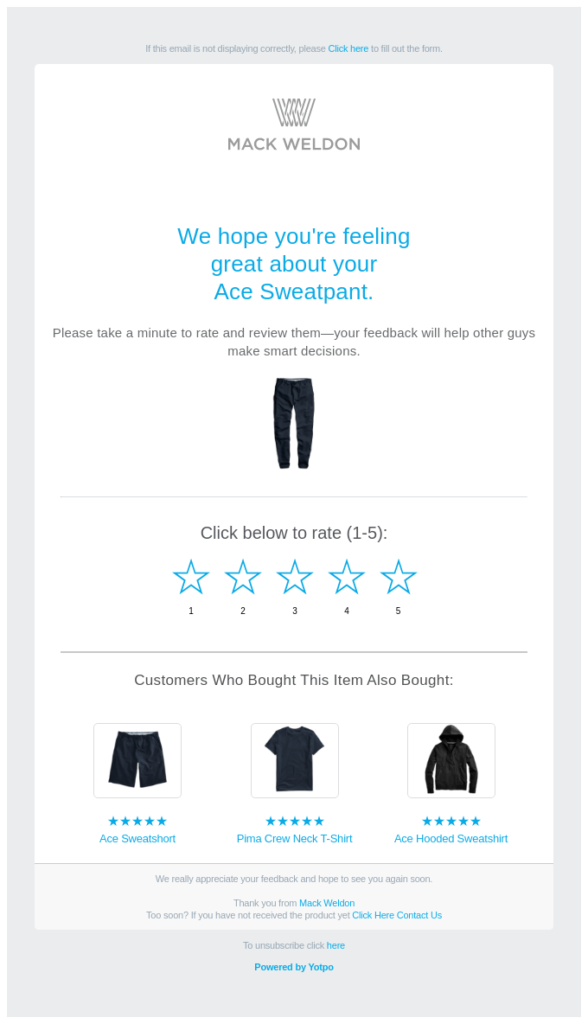
You’ll get fewer responses if existing customers need to create a new account to leave a review. For example, a restaurant will probably see better results asking for a Google review than one on OpenTable. Additionally, integrating a restaurant tablet ordering system can streamline the process for customers to share their feedback.
Reach out on different channels
Don’t just rely on email marketing. Find the most common customer channels and, if possible, automate a review request there as well. For example, consider sending messages via social media or SMS.
Alternatively, you can send the main request through an email campaign and only follow up using other channels. Testing a few different delivery channels can dramatically boost your engagement rates
Divide customers by their experience
As we mentioned earlier, it’s a good idea to screen customers for reviews to avoid negative feedback. But it’s a common pitfall only to ask your most satisfied customers to share their positive experiences.
Most of your customers are probably less-than-raving fans, but if they’ve had a good experience, they’ll usually still leave a positive review. Since most reviewers are in this middle category, be sure to ask them. Otherwise, you could be skipping some of your best potential reviewers.
Make it fast
If you’re currently asking customers for reviews manually, you’ll likely see an immediate surge in responses just from asking them sooner. Customers leave the best reviews when a product is fresh on their minds.
It makes sense, too — what do you remember about a product you bought last week? Ideally, send requests for reviews on the day of the customer interaction. Depending on your trigger, this could be the sale itself, when a customer received the product or another high point of the interaction.
Respond to reviews
Recent research showed that 73% of customers “always” or “regularly” pay attention to how local businesses respond to reviews.
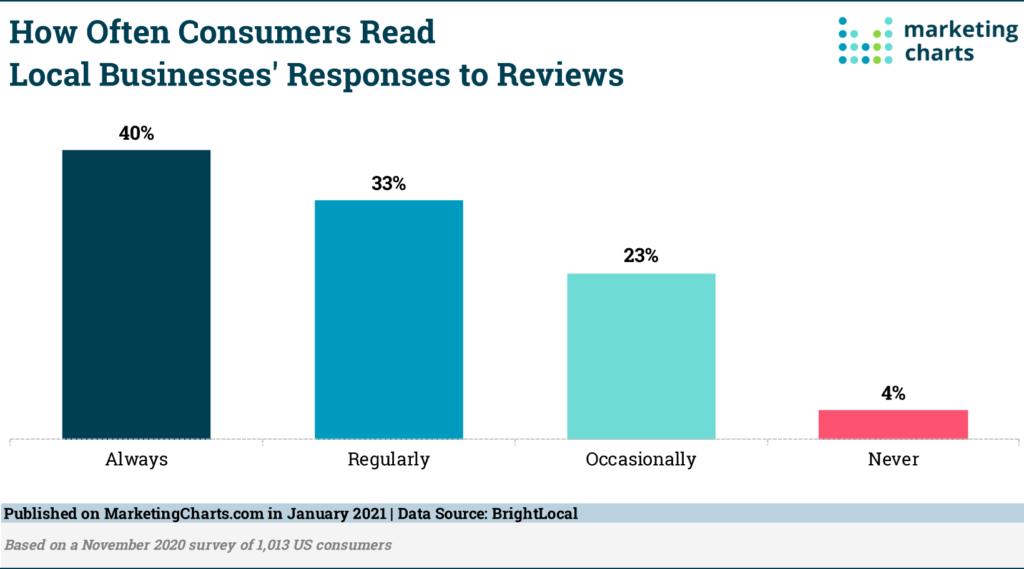
Responding to reviews on any platform that permits it is a great way to show your brand personality. Handle negative reviews politely, and never act defensively. An argumentative reply will only make a negative experience seem worse.
But some of the best opportunities lie with positive reviews. It’s easy to forget about them, but they’re your happiest customers. Thanking the customer for leaving a review is a simple way to show your brand personality and reward your biggest fans.
Highlight reviews on your site
Finally, you can encourage reviews indirectly by highlighting them on your website. You can feature individual testimonials or include badges from third-party sites like G2 Crowd or Trustpilot.
Featuring reviews shows potential customers your credibility and can help motivate existing customers to share their stories, too. In some instances, prominent reviews can even encourage customers to leave their own to be featured on your site.
With these strategies in place, you’ll have an effective automated process for collecting customer reviews.
The bottom line on customer review automation
If you’re struggling to acquire and retain customers in your business, automated reviews may be the solution you’re looking for.
Every testimonial adds to your business’s credibility, and automation makes it easy to ask. A robust review profile on your own site or a third-party platform boosts your trust and increases conversion rates.
Even better, reviews can help increase existing customer engagement. Customers are more likely to stay with your brand if they leave a positive review, and an automated system can encourage more customers to do just that.
Automated tools are a helpful tool that can help take your business to the next level.



